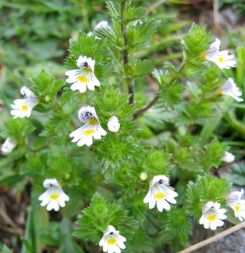 |
Found in abundance in summer time on our heaths, and on mountains near the sea, this delicate little plant, the Euphrasia officinalis, has been famous from earliest times for restoring and preserving the eyesight. The Greeks named the herb originally from the linnet, which first made use of the leaf for clearing its vision, and which passed on the knowledge to mankind. The Greek word, euphrosunee, signifies joy and gladness. The elegant little herb grows from
two to six inches high, with deeply-cut leaves, and numerous white or purplish tiny flowers variegated with yellow; being partially a parasite, and preying on the roots of other plants. It belongs to the order of scrofula-curing plants; and, as proved by positive experiment (H.), the Eyebright has been recently found to possess a distinct sphere of curative operation, within which it |
manifests virtues which are as unvarying as they are truly potential. It acts specifically on the mucous lining of the eyes and nose, and the uppermost throat to the top of the windpipe, causing, when given so largely as to be injurious, a profuse secretion from these parts; and, if given of reduced strength, it cures the same troublesome symptoms when due to catarrh.
An attack of cold in the head, with copious running from the eyes and nose, may be aborted straightway by giving a dose of the infusion (made with an ounce of the herb to a pint of boiling water) every two hours; as, likewise, for hay fever. A medicinal tincture (H.) is prepared from the whole plant with spirit of wine, of which an admirably useful lotion may be made together with rose water for simple inflammation of the eyes, with a bloodshot condition of their outer coats.
Thirty drops of the tincture should be mixed with a wineglassful of rosewater for making this lotion, which may be used several times in the day.
What precise chemical constituents occur in the Eyebright beyond tannin, mannite, and glucose, are not yet recorded. In Iceland its expressed juice is put into requisition for most ailments of the eyes. Likewise, in Scotland, the Highlanders infuse the herb in milk, and employ this for bathing weak, or inflamed eyes. In France, the plant is named Casse lunettes; and in Germany, Augen trost, or, consolation of the eye.
Surely the same little herb must have been growing freely in the hedge made famous by ancient nursery tradition:
"Thessalus acer erat sapiens proe civibus unus
Qui medium insiluit spinets per horrida sepem.
Effoditque oculos sibi crudelissimus ambos.
Cum vero effosos orbes sine lumine vidit
Viribus enisum totis illum altera sepes
Accipit, et raptos oculos cito reddit egenti."
"There was a man of Thessuly, and he was wondrous wise;
He jumped into a quick set hedge, and scratched out both his eyes;
Then, when he found his eyes were out, with all his might and main
He jumped into the quick set hedge, and scratched them in again."
Old herbals pronounced it "cephalic, ophthalmic, and good for a weak memory." Hildamus relates that it restored the sight of many persons at the age of seventy or eighty years. "Eyebright made into a powder, and then into an electuary with sugar, hath," says Culpeper, "powerful effect to help and to restore the sight decayed through years; and if the herb were but as much used as it is neglected, it would have spoilt the trade of the maker."
On the whole it is probable that the Eyebright will succeed best for eyes weakened by long-continued straining, and for those which are dim and watery from old age. Shenstone declared, "Famed Euphrasy may not be left unsung, which grants dim eyes to wander leagues around"; and Milton has told us in "Paradise Lost", Book XI:
"To nobler sights
Michael from Adam's eyes the film removed,
Then purged with _Euphrasy_ and rue
The visual nerve, for he had much to see."
The Arabians I mew the herb Eyebright under the name "Adhil", It now makes an ingredient in British herbal tobacco, which is smoked most usefully for chronic bronchial colds. Some sceptics do not hesitate to say that the Eyebright owes its reputation solely to the fact that the tiny flower bears in its centre a yellow spot, which is darker towards the middle, and gives a close resemblance to the human eye; wherefore, on the doctrine of signatures, it was pronounced curative
of ocular derangements. The present Poet Laureate speaks of the herb as:--
"The Eyebright this.
Whereof when steeped in wine I now must eat
Because it strengthens mindfulness."
Grandmother Cooper, a gipsy of note for skill in healing, practiced the cure of inflamed and scrofulous eyes, by anointing them with clay, rubbed up with her spittle, which proved highly successful. Outside was applied a piece of rag kept wet with water in which a cabbage had been boiled. As confirmatory of this cure, we read reverently in the "Gospel of St. John" about the man "which was blind from his birth," and for whose restoration to sight our Savior "spat on the
ground, and made clay of the spittle, and anointed the eyes of the blind man with the clay." More than one eminent oculist has similarly advised that weak, ailing eyes should be daily wetted on waking with the fasting saliva. And it is well known that "mothers' marks" of a superficial character, but even of a considerable size, become dissipated by a daily licking with the mother's tongue. Old Mizaldus taught that "the fasting spittle of a whole and sound person both quite
taketh away all scurviness, or redness of the face, ringworms, tetters, and all kinds of pustules, by smearing or rubbing the infected place therewith; and likewise it clean puts away thereby all painful swelling by the means of any venomous thing as hornets, spiders, toads, and such like." Healthy saliva is slightly alkaline, and contains sulphocyanate of potassium.


